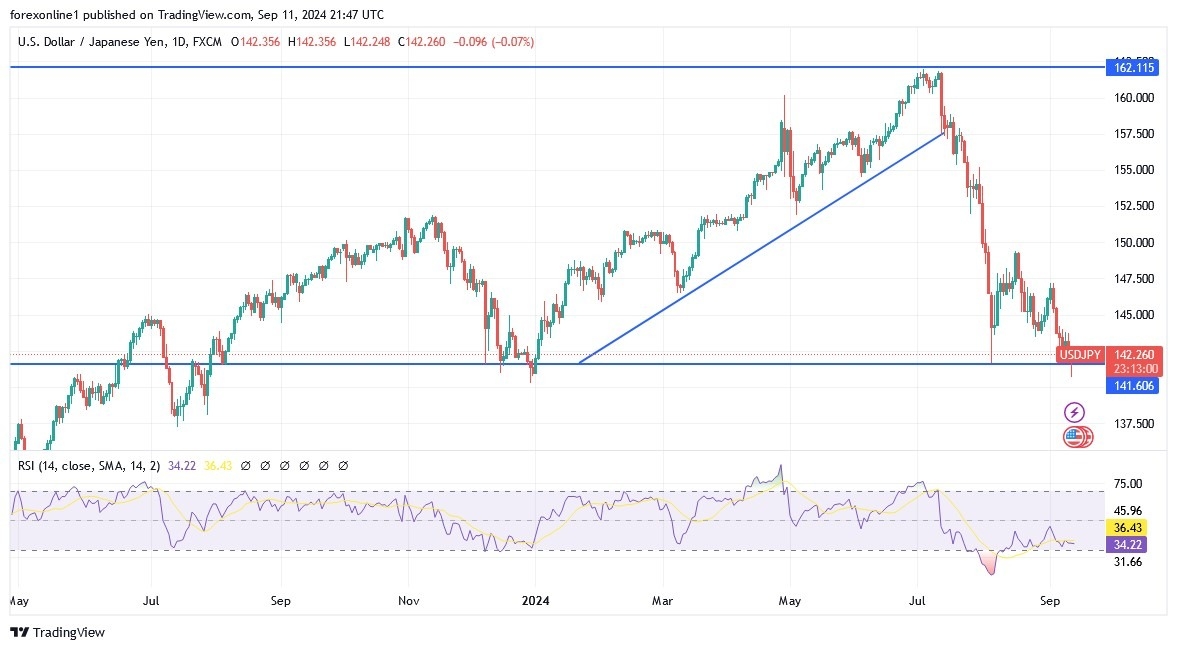USD/JPY Analysis: Losses Form Major Support
- The USD/JPY exchange rate continued its downtrend ahead of upcoming interest rate decisions from the Bank of Japan and the US Federal Reserve.
- According to forex market trading, the pair fell to a low of 140.70 on Wednesday morning, its lowest level since January 2, 2024, and about 13% from its highest level this year.
- It then stabilized higher around the 142.45 resistance level after the announcement of US inflation figures, which helped the US dollar achieve its gains.
(Click on image to enlarge)
Bank of Japan Decision
The USD/JPY continued its downward trend after a Bank of Japan official hinted at further interest rate hikes. In a statement, Junko Nakagawa said that conditions in the country would remain easier even if these increases occurred. Furthermore, this statement came as the Bank of Japan is preparing to make its next interest rate decision on September 20. This will be a crucial meeting as the bank made a surprise 0.25% increase at its last meeting, shocking the financial market.
In recent statements, officials, including Kazuo Ueda, have hinted at another hike due to stubbornly high inflation. The latest economic figures showed that the core consumer price index rose to 2.8% in July, above the median estimate of 2.7%. Also, the CPI figure was well above the year-to-date low of 2.2% and the Bank of Japan’s target of 2.0%. Therefore, the interest rate cut is aimed at helping to reduce inflation, in part by slowing the pace of wage growth and strengthening the Japanese yen.
However, there are risks to further interest rate hikes by the Bank of Japan. First, there are signs that the Japanese economy is not doing well. Meanwhile, a report released this week showed that the Japanese economy expanded by 0.7% in the second quarter after contracting by 0.6% in the first quarter. This growth translated into an annual growth rate of 2.9%. While these numbers were better than those recorded in the first quarter, they were below the expected growth of 0.9% and 3.1%, respectively. The Japanese Statistics Bureau attributed this weakness to weak external demand, which fell by 0.1%.
Private spending and capital spending rose by 0.9% and 0.8% in the second quarter, which was lower than the expected growth of 1.0% and 0.9%. However, there are some positives for the Japanese economy. For one thing, the price of most commodities, including crude oil, has fallen sharply recently. Brent and WTI crude fell to $69 and $66, respectively. Clearly, Japan does well when energy prices fall as it is one of the world’s largest importers.
US Federal Reserve Decision
The USD/JPY pair declined due to evidence that the Federal Reserve will continue to cut US interest rates next week. According to the economic calendar, recent economic data has shown that the US economy is slowing. Reports from S&P Global and the Institute for Supply Management (ISM) showed that manufacturing purchasing managers' indices remained below the growth phase of 50 in August. The rule, a PMI reading below 50 is a sign of sector contraction. Another prominent report came from ADP and the Bureau of Labor Statistics (BLS). According to ADP, the private sector created fewer than 100,000 jobs in August. Furthermore, the official non-farm payrolls data revealed that the unemployment rate remained above 4.2% as the economy created 141,000 jobs.
Meanwhile, there are signs that inflation in the country has been easing. The upcoming US CPI data is expected to show that the headline figure fell from 2.9% in July to 2.6% in August while the core CPI moved from 3.2% to 3.1%.
Historically, inflation figures are important to the US Federal Reserve as they form part of its dual mandate. In this case, these figures will not have a significant impact on the USD/JPY pair, as the Fed has already hinted that it will cut interest rates at its next meeting. Therefore, a rate cut by the Fed and a rate hike by the Bank of Japan would narrow the spread between Japanese and US yields, leading to further concerns about the carry trade.
What is a carry trade?
A carry trade is a situation where investors borrow in a country with low interest rates to invest in a country with high interest rates. In this case, investors used the low interest rates in Japan to invest in the United States, which means that the reversal is starting to happen now.
USD/JPY Technical Analysis and Expectations Today:
The USD/JPY exchange rate peaked at 161.98 last July and then suffered a sharp reversal after the Bank of Japan raised interest rates. Most importantly, the dollar/yen pair has formed a death cross, where the 200-day and 50-day exponential moving averages have crossed. In most cases, this pattern leads to further declines. The pair also fell below the key support level of 141.75, its lowest level since August 5, invalidating the double bottom pattern that was forming. Technically, the MACD indicator also remained below the neutral line while the Relative Strength Index (RSI) moved below the 50 neutral lines. Therefore, the strongest resistance path for the pair is downward, and the next point to watch is the psychological level of 140.
More By This Author:
Gold Analysis: Stable Ahead Of US Inflation ReportEUR/USD Analysis: Faces Pressure Ahead Of Key Data
EUR/USD Analysis: Key Events Ahead
Disclosure: DailyForex will not be held liable for any loss or damage resulting from reliance on the information contained within this website including market news, analysis, trading signals ...
more



